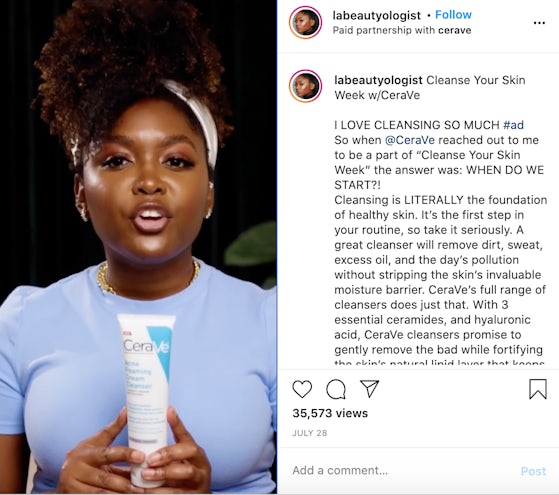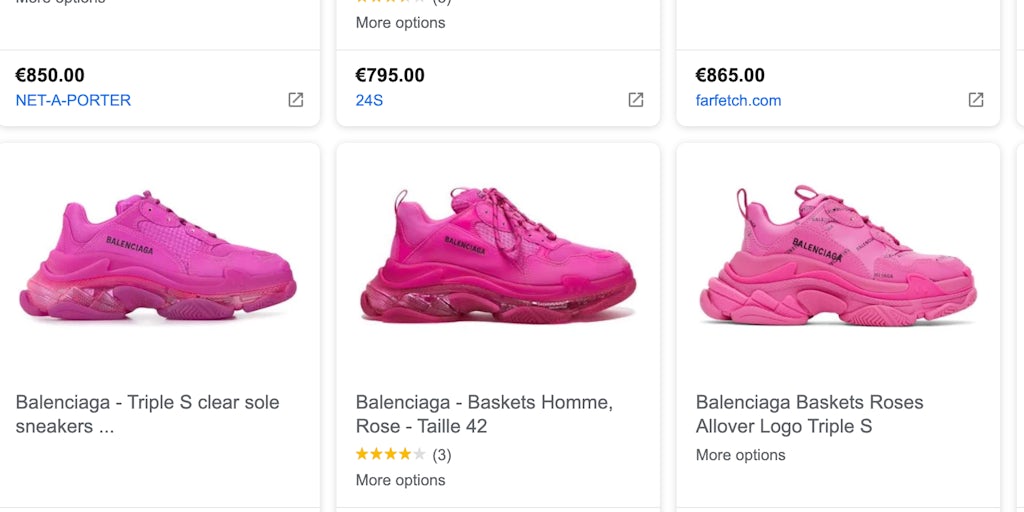The Skin-Care Brand That’s Unexpectedly All Over TikTok | The Business of Beauty, BoF Professional
NEW YORK, United States – When actor/director/producer Tyler Perry tweeted out a picture of himself in January with actress Cicely Tyson, expressing disbelief at her age and suggesting that maybe he should start using moisturizer, CeraVe co-founder Tom Allison jumped into the thread and offered him a year’s worth of products. Perry responded with a picture of himself holding a bottle of the brand’s popular hydrating cleanser. He was already a fan.
“I was like, ‘Hey, what about me?’ as a joke,” said Tiara Willis, when she saw the tweet. Willis, 19, posts under the handle @makeupforWOC and has 260,000 followers on Twitter and almost 200,000 on Instagram. She first gained a following as a makeup enthusiast, but after graduating from high school early, she became a licensed aesthetician and pivoted to doling out skin-care advice on the internet in between clients. She had been recommending CeraVe to her friends and followers for at least a year. Allison messaged her and the brand sent her a case of products.
Willis and Perry are not alone in their devotion to CeraVe. Shelves at Target and Walmart are being stripped of the brand’s products by young fans who are buying three bottles of its coveted cleansers and moisturizers at a time — when they can find them.
It used to be embarrassing to buy drugstore brands. That savviness is cool now.
While the brand has been growing steadily for a while, a rising class of Gen Z “skinfluencers” has elevated the workaday skin brand into a viral hit, despite its lack of either Glossier’s aesthetic sensibilities or the backing of an alpha-influencer like Kylie Jenner. One of its biggest evangelists, TikTok beauty star Hyram Yarbro (over six million followers) recommended the L’Oréal-owned CeraVe consistently in the spring. The attention he drove to the brand landed him two paid campaigns with CeraVe over the summer.
CeraVe has seen a 67 percent increase in influencer posts and over 300 percent increase in engagement in the first half of this year compared to 2019, according to Traackr, an influencer marketing firm. The attention is translating into sales for L’Oréal. The firm’s active cosmetics division, which includes CeraVe, the prestige brand Skinceuticals, and LaRoche-Posay, is the only division that had positive growth in the first six months of this year. CeraVe was “the number one brand in terms of contribution to the division’s growth,” L’Oréal said in its July earnings report.
CeraVe’s reputation for being cheap and effective plays right into changes underway in the beauty influencer world. The ingredient conversation is important to the new generation of skin-care consumers, who have driven sales of other affordable brands like Deciem’s The Ordinary, which focuses on promoting individual ingredients and building a regimen based on need. CeraVe is a natural fit in this trend because it was touting its proprietary blend of ceramides and lipid molecules that help to protect the skin, long before Instagram even existed.
“[Influencers are] cutting through the more traditional marketing around skin-care, that you have to spend a lot of money,” said Holly Jackson, director of global services at Traackr. “They are digging in to look at the underlying ingredients and focusing on the efficacy of those ingredients.”
CeraVe launched in 2005 as a mass-market brand with three products — a hydrating cleanser and two different moisturizers, according to Allison, who has been with the brand since its founding and is currently the global vice president of professional marketing. The products were meant to be pillars used before and after dermatologist-prescribed treatments. Allison calls it “mass medical” positioning. (He did a stint at Galderma, maker of CeraVe competitor Cetaphil, which has similar dermatologist credibility and positioning.)
CeraVe was sold to pharmaceutical company Valeant in 2008, where it grew its product line. Dermatologists helped guide its messaging and even its packaging. The simple jars and bottles are colour-coded based on use. Dermatologists wanted to just be able to tell their patients to “get the blue tub or the green cleanser,” according to Allison. The product sizes are large because they’re meant to be for long-term use to support a six-month regimen of acne treatment or chronic eczema. Prices are slightly higher than some mass brands, ranging from $10 for a cleanser to over $20 for anti-ageing products.
In 2017, L’Oréal acquired CeraVe and two other small medically-focused skin brands from Valeant for $1.3 billion. L’Oréal took CeraVe global, where it is now sold in 35 countries.
L’Oréal put its massive marketing machine to work, pumping out traditional ad campaigns and employing a large sales team to target dermatologists, who hand out samples in office and recommend CeraVe’s products liberally. The brand grew steadily, with 35 percent growth in its moisturizer sales in 2019, according to Mintel, a market research firm. It was the most discussed beauty brand on Reddit in 2019.
Then came the pandemic and the ascendancy of TikTok. Young consumers sought out products that worked and that they could afford. Posting before and after pictures helped influencers go viral on TikTok, and their followers wanted those results. Mass merchandisers like Target and Walmart, already the biggest points of sale for beauty, remained open as essential businesses, ensuring the products were accessible. Skinfluencers are increasingly broadcasting to followers that expensive products don’t necessarily work better.
“It used to be embarrassing to buy drugstore brands,” said Shannon Romanowski, a director at Mintel. “That savviness is cool now.”

Nayamka Roberts-Smith, a young aesthetician that goes by the handle @labeautyologist, in a CeraVe campaign | Screenshot: Instagram
CeraVe had formerly relied on reaching Gen Z via their dermatologists, but Hyram’s devotion to the brand and the subsequent halo effect promoted a “dramatic acceleration of awareness,” said Allison. It opened up a marketing channel the brand had not previously considered. It has since done three paid partnerships with influencers — two with Hyram and one with Nayamka Roberts-Smith, a young aesthetician that goes by the handle @labeautyologist.
Gen Z trusts the peers they see on social media who have become ingredient experts. Willis, the Twitter aesthetician, says that some of her clients are dissatisfied with interactions they’ve had with dermatologists, whose time is limited in-office appointments. (Willis, who is not yet on TikTok, says she has been in talks with CeraVe’s marketing team about potential collaborations.)
Mass brands may need to start rethinking how they run influencer campaigns. Neutrogena has seen a decline in its influencer marketing metrics, which Traackr’s Jackson attributes to its smaller presence on TikTok and reliance on older sponsored content tropes like influencers just holding up a product and talking about its benefits. Influencers who actually demonstrate using the product or post before and after shots generate much more conversation.
Vaseline has seen skyrocketing amounts of engagement, mostly from organic posts on TikTok highlighting the brand’s many uses. Olay, which was still doing Super Bowl ads last year with traditional celebrity endorsers, did a paid TikTok post with creator @yayayayoung that garnered over 18 million views.
Popularity does come with problems. CeraVe has been experiencing shortages at some of its retailers. “It has been an issue in terms of keeping up with demand,” said Allison. L’Oréal has ramped up production, amid the global supply chain and transport issues that are plaguing many industries.
When asked if he’s worried about TikTok being shut down in the US, Allison downplayed any concerns he might have.
“I would anticipate if TikTok were to go away, something new would be created to fill that void,” he said.
THIS WEEK IN BEAUTY
The Hut Group acquires Perricone MD. The UK-based owner of Espa and Lookfantastic.com bought the American prestige skin care brand for $60 million, mere weeks after the group’s successful IPO debut on the London Stock Exchange.
Kylie Cosmetics was the victim of a Shopify data breach. Two Shopify employees stole customer data from about 100 Shopify stores, and Kylie Jenner’s brand was one of them.
Revlon attempts a second debt swap. The struggling company, which was declining before Covid and is now in dire straits, is trying for a financial turnaround.
Latinx beauty influencers push for better opportunities. Spanish-speaking influencers who are popular in countries besides just the US find it more difficult to land brand campaigns.
Italian makeup brand Kiko Milano casts a campaign, wants “no ethnics.” In a reported leaked email, the brand specifically used that word, clarifying: “The brief is always the same: Caucasic, Mediterranean, blonde, brown, and black hair.”
“Biden Beauty” exists. A mysterious group of “anonymous beauty insiders,” who apparently have the blessing of the Biden campaign, launched a blue makeup sponge for $20.20 — all proceeds will go to the Democratic National Committee and the Biden/Harris campaign.
Trump wrote off $70,000 worth of hair styling. It’s one of the least important yet most entertaining tidbits to come out of the New York Times’ explosive report on President Trump’s tax returns.
Related Articles:
Gen Z Buys Everything Online, Except Beauty Products



